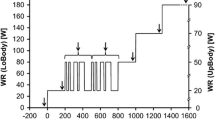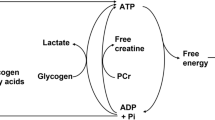Summary
We postulated that the commonly observed constant linear relationship between\(\dot V_{{\text{O}}_{\text{2}} }\) and work rate during cycle ergometry to exhaustion is fortuitous and not due to an unchanging cost of external work. Therefore we measured\(\dot V_{{\text{O}}_{\text{2}} }\) continuously in 10 healthy men during such exercise while varying the rate of work incrementation and analyzed by linear regression techniques the relationship between\(\dot V_{{\text{O}}_{\text{2}} }\) and work rate (Δ\(\dot V_{{\text{O}}_{\text{2}} }\)/ Δwr). After excluding the first and last portions of each test we found the mean ±SD of the δ\(\dot V_{{\text{O}}_{\text{2}} }\)/ Δwr in ml · min−1· W−1 to be 11.2±0.15, 10.2±0.16, and 8.8±0.15 for the 15, 30, and 60 W·min−1 tests, respectively, expressed as ml·J−1 the values were 0.187±0.0025, 0.170±0.0027 and 0.147±0.0025. The slopes of the lower halves of the 15 and 30 W·min−1 tests were 9.9±0.2 ml·min−1·W−1 similar to the values for aerobic work reported by others. However the upper halves of the 15, 30, and 60 W·min−1 tests demonstrated significant differences: 12.4±0.36 vs 10.5±0.31 vs 8.7±0.23 ml·min−1·W−1 respectively. We postulate that these systematic differences are due to two opposing influences: 1) the fraction of energy from anaerobic sources is larger in the brief 60 W·min−1 tests and 2) the increased energy requirement per W of heavy work is evident especially in the long 15 W·min−1 tests.
Similar content being viewed by others
References
Asmussen E (1965) Muscular exercise. In: Fenn WO, Rahn H (Eds) Handbook of physiology. Respiration, Sect 3, vol II, ch 36. Am Physiol Soc, Washington, DC, pp 939–978
Astrand P, Rodahl K (1970) Textbook of work physiology. McGraw-Hill, New York, p 346
Astrand P, Hallback I, Hedman R, Saltin B (1963) Blood lactates after prolonged severe exercise. J Appl Physiol 18:619–622
Beaver WL, Lamarra N, Wasserman K (1981) Breath-by-breath measurement of true alveolar gas exchange. J ApplPhysiol 51:1661–1675
Brooks GA (1986) The lactate shuttle during exercise and recovery. Med Sci Sports Exerc 18:360–368
Casaburi R, Storer TW, Ben-Dov I, Wasserman K (1987) Effect of endurance training on possible determinants of\(\dot V_{{\text{O}}_{\text{2}} }\) during heavy exercise. J Appl Physiol 62:199–207
Cotes JE (1975) Lung function, 3rd ed, Blackwell, Oxford, p 311
Davis JA, Whipp BJ, Lamarra N, Huntsman DJ, Frank MH, Wasserman K (1982) Effect of ramp slope on measurement of aerobic parameters from the ramp exercise test. Med Sci Sports Exerc 14:339–343
DiPrampero PE (1981) Energetics of muscular exercise. Rev Physiol Biochem Pharmacol 89:143–222
Gaesser GA, Brooks G (1975) Muscular efficiency during steady-rate exercise effects of speed and work rate. J Appl Physiol 38:1132–1139
Hartley LH, Mason JW, Hogan RP, Jones LG, Kotchen TA, Mougey EH, Wherry FE, Pennington LL, Ricketts PT (1972) Multiple hormonal responses to graded exercise in relation to physical training. J Appl Physiol 33:602–606
Hughson RL, Inman MD (1986) Oxygen uptake kinetics from ramp work tests: variability of single test values. J Appl Physiol 61:373–376
Jones NL, Campbell EJM (1982) Clinical exercise testing. 2nd ed, Saunders, Philadelphia, pp 120, 246
Karlsson J, Nordesjo L-O, Jorfeldt L, Saltin B (1972) Muscle lactate, ATP, and CP levels during exercise after physical training in man. J Appl Physiol 33:199–203
Katz J (1986) The application of isotopes to the study of lactate metabolism. Med Sci Sports Exerc 18:353–359
Keul J, Doll E, Keppler D (1972) Energy metabolism of human muscle. University Park Press, Baltimore, p 313
Kitamura K, Jorgensen CR, Gobel FL, Taylor HL, Yang Y (1972) Hemodynamic correlates of myocardial oxygen consumption during upright exercise. J Appl Physiol 32:516–522
Krebs HA (1964) Glyconeogenesis. Croonian lecture. Proc R Soc(Lond) 159:545–560
Nagle F, Balke B, Baptista B, Alleyia J, Howley E (1971) Compatability of progressive treadmill, bicycle and step tests based on oxygen uptake responses. Med Sci Sports 3:149–154
Nelson RN, Gobel FL, Jorgensen CR, Wang K, Wang Y, Taylor HL (1974) Hemodynamic predictors of myocardial oxygen consumption during static and dynamic exercise. Circulation 20:1179–1189
Pahud E, Ravussin E, Jequier E (1980) Energy expended during oxygen deficit period of submaximal exercise in man. J Appl Physiol 48:770–775
Saltin B, Hermansen L (1966) Esophageal, rectal, and muscle temperature during exercise. J Appl Physiol 21:1757–1762
Shephard RJ (1966) The oxygen cost of breathing during vigorous exercise. Quart J Exptl Physiol 51:336–350
Sjostrom L, Schuts Y, Gudinchet F, Hegnell L, Pittet PG, Jequier E (1983) Epinephrine sensitivity with respect to metabolic rate and other variables in women. Am J Physiol 245:E431–442
Spiro SG (1977) Exercise testing in clinical medicine. Br J Dis Chest 71:145–172
Wasserman K, Whipp BJ (1975) Exercise physiology in health and disease. Am Rev Respir Dis 112:219–249
Wasserman K, Hansen JE, Sue DY, Whipp BJ (1987) Principles of exercise testing and interpretation. Lea and Febiger, Philadelphia, pp 1–214
Whipp BJ, Davis JA, Torres F, Wasserman K (1981) A test to determine parameters of aerobic function during exercise. J Appl Physiol 50:217–221
Whipp BJ, Pardy RL (1986) Breathing during exercise. In: Fishman AP (Ed) Handbook of physiology. The respiratory system III, sect 3, vol III, ch 34. Am Physiol Soc, Bethesda, pp 605–629
Younes M (1984) Interpretation of clinical exercise testing in respiratory disease. In: Loke J (Ed) Clinics in chest medicine. Saunders, Philadelphia, pp 189–206
Author information
Authors and Affiliations
Rights and permissions
About this article
Cite this article
Hansen, J.E., Casaburi, R., Cooper, D.M. et al. Oxygen uptake as related to work rate increment during cycle ergometer exercise. Europ. J. Appl. Physiol. 57, 140–145 (1988). https://doi.org/10.1007/BF00640653
Accepted:
Issue Date:
DOI: https://doi.org/10.1007/BF00640653




